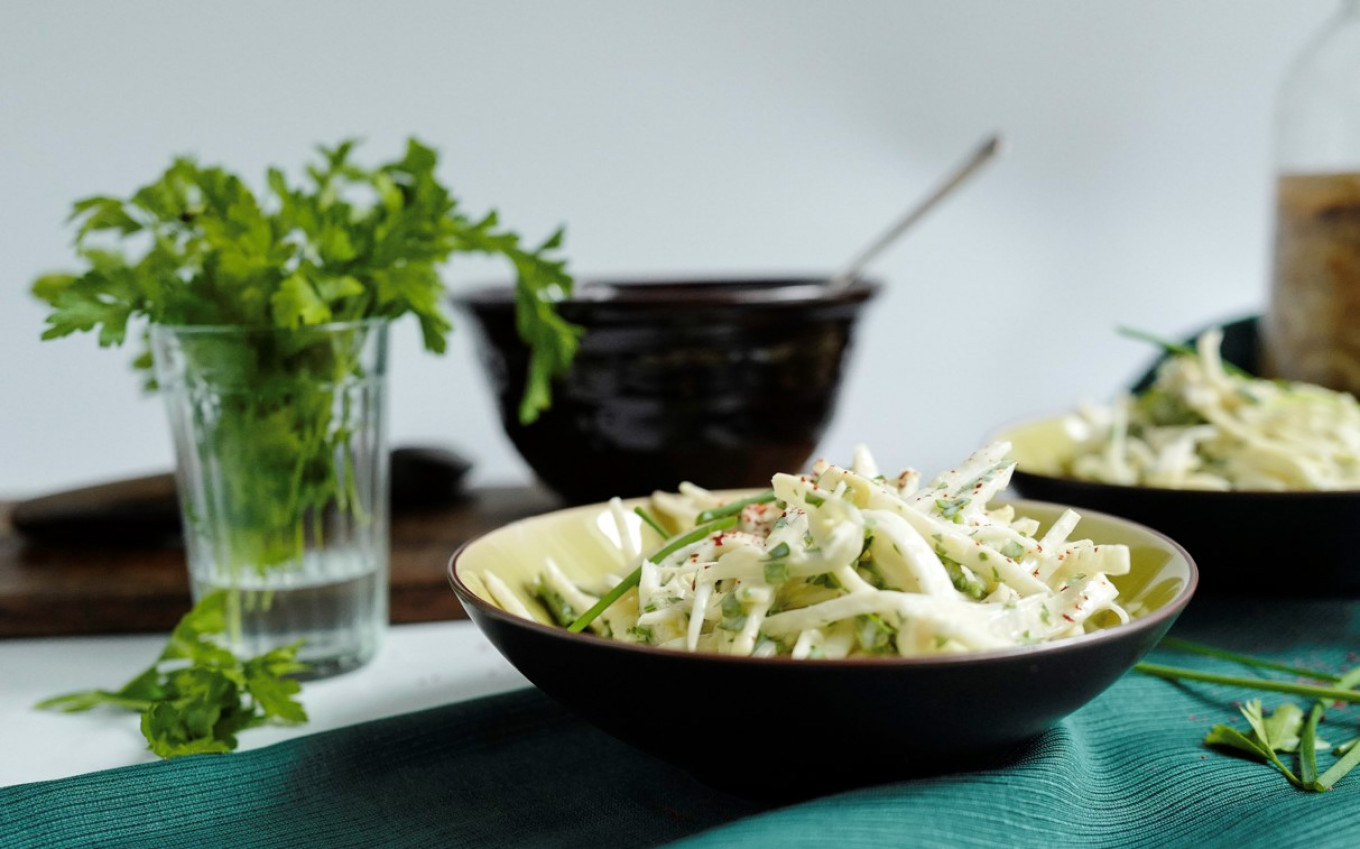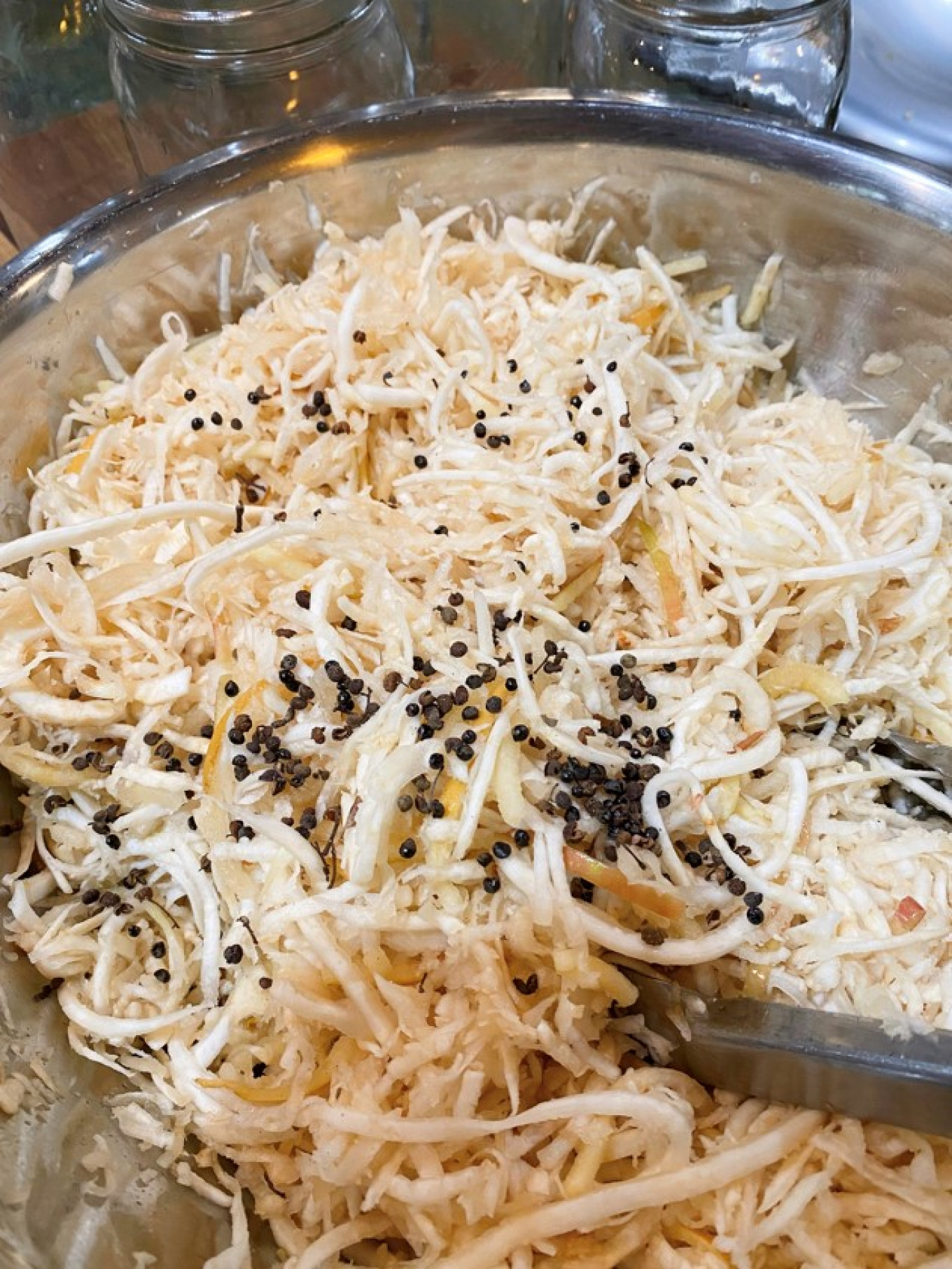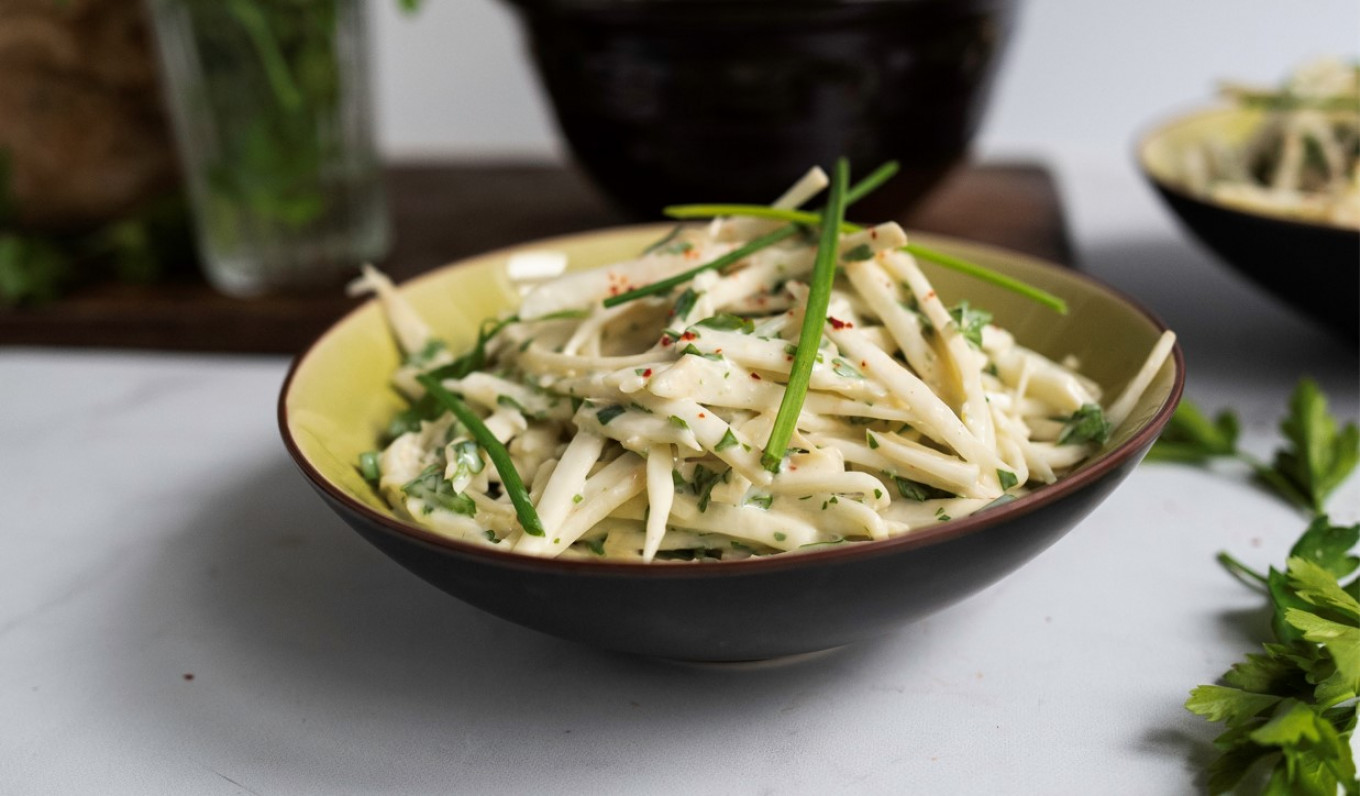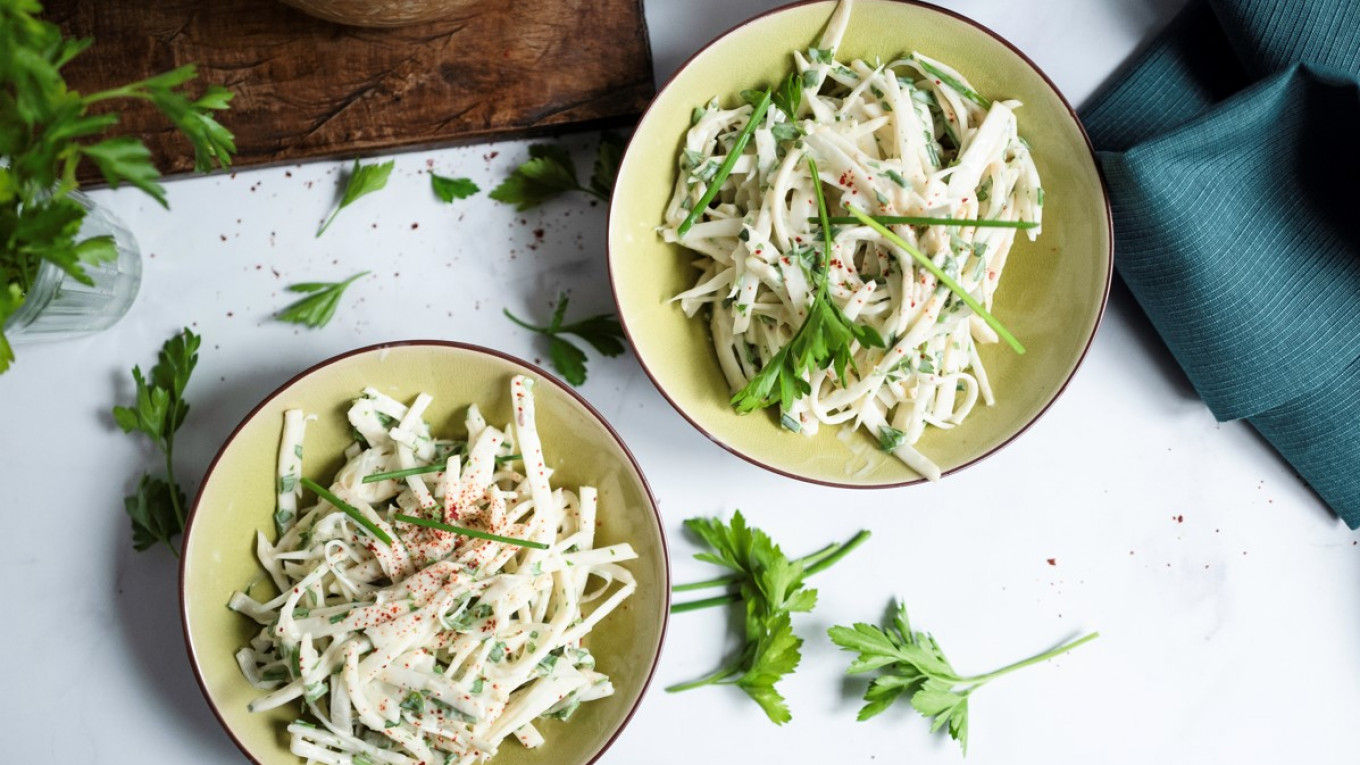Winter vegetables can be tough nuts to crack, if that’s not mixing a metaphor. Their admirably sturdy longevity, which makes them highly prized in colder climates, is often thanks to an almost impenetrable exterior. And if you are feeling rushed or slightly fragile, the thought of tackling that exterior to get to the good stuff underneath can be daunting. Many is the time I’ve looked at an acorn squash, considered it, and then turned to a much simpler potato or turnip.
This is particularly true of celeriac or celery root, which has a tough and knotty exterior that can deter even the most seasoned or enthusiastic cook. But time spent paring away that exterior is rewarded with a versatile vegetable, one with a unique flavor that somehow is both nutty and anise-y at the same time. I find celery root mash far more compelling than mashed potatoes, and no pot of “green soup” — my essential restorative version of leek-based soup with leafy greens — is complete without several chunks of celery root to bring it all together.
One of my first culinary encounters with celery root was in the Korean salad section of Leningradsky market, where spicy pickles and ferments glitter under the neon lights of the market building. Here you can pick up kimchi, morkovcha — the beloved Russian Korean carrot salad — a cheap mandoline slicer, and a fantastically spicy pickled celery root salad that is almost too hot to handle, with a double punch of wasabi and chilis. One small flimsy plastic container of this is enough to spice up a week’s worth of meals: everything from a plain grilled steak to a lackluster potato salad. It was then that I developed a keen regard for raw celeriac and began to develop recipes that showcased it, although perhaps packed slightly less heat.

Two of my favorites are listed below, which can be made separately, or combined for a particularly flavorful cold salad that pairs magnificently with ham, pork, beef, chicken, and turkey, making it the ideal holiday side dish. Fermenting celeriac root with Asian pears and apples takes a few weeks and the resulting pickled celery is on the sweet side, but very flavorful and perfect for sandwiches, alongside sausages, on burgers, grain bowls, or on top of “green soup” as a lovely salty, sour compliment to the creamy soup.
My mother, also a celeriac fan, was visiting when I made a test batch of my version celeriac remoulade, a classic French dish that gets an injection of Slavic oomph with the addition of sour cream and a small amount of the pickled celery root. She sampled a bowl with relish, then asked, “Perhaps we might substitute this for one of those mayonnaise salads we have on New Year’s Eve?”
Hope dies last, as the Russians say.
“Chance would be a fine thing,” I said, knowing that my husband would never agree to forgo salad Olivier or herring under fur coat for something a) meatless, and b) French. But I may just add this remoulade to the New Year’s Eve menu. It has a lovely tangy freshness about it that perks everything up considerably. Perhaps even herring under fur coat?
Don’t let the formidable celeriac intimidate you. Choose a large, very sharp knife and cut off the two knotty ends first to give you a firm base. Then, cutting away from yourself, slice the skin off from top to bottom, rubbing the exposed flesh with half a lemon to ensure it doesn’t discolor. Use a peeler to clean off any remaining skin, then grate the celeriac in a food processor fitted with a grater blade, spiralize it, or use a mandoline to get thin julienne slices. For the remoulade, the pieces should not be too small or too large: once celeriac is cut, it will go limp rather quickly. And slot this tangy, delicious salad into your holiday and everyday lineup. You’ll be glad you did.

Russian-Korean Pickled Celery Root
Ingredients
- 2 medium-to-large celery roots, skin completely removed
- 2 Asian pears
- 1 tart apple
- 1 Tbsp caraway seeds
- 2 Tbsp Szechuan peppercorns (or plain black peppercorns)
- Salt (amount will depend on the final weight of the pears and celery root)
- 2 Bay leaves
Preparation
- Grate the celery root, pear, and apple in a food processor or on a mandoline. Calculate 2% of the combined weight of the grated apple, pear, and celery root (minus cores) and add that much salt to the mixture and toss to combine. Allow the mixture to sit for 45-60 minutes, covered with a clean cloth.
- Toast the caraway seeds and Szechuan peppercorns in a skillet for 2-3 minutes until their flavor amplifies. Crush them lightly with the back of a spoon or in a mortar and pestle. Set aside.
- Return to the mixture and massage the salt into the celery root mixture with your hands or a sauerkraut pounder. Continue until liquid forms. Add the caraway seeds and Szechuan peppercorns and toss to combine.

- Place the Bay leaves at the bottom of a clean 4-quart glass jar, then pack the celery root into the jar, pounding each layer down over the next. There should be some liquid on the surface. If there isn’t, keep pounding.
- Weight the celery root down with glass weights or a plastic bag filled with water and attach a lid. If you have an airlock, do use that. If not, be sure to “burp” the jar once every day: crack the lid and allow a bit of air to escape, then tighten again.
- Leave the celery root in a cool, dry, dark place for at least 7 days. Decant into smaller jars and store in the refrigerator for up to 2 weeks.
Recipe adapted from The Guardian
Celery Remoulade with Pickled Celery Root
Ingredients
- 1 medium-to-large sized celery root, skin removed
- ⅔-cup (156 ml) mayonnaise
- ⅓-cup (80 ml) sour cream or Greek yogurt
- 2 Tbsp Dijon mustard
- Zest and juice of one lemon
- ½-tsp white pepper
- ⅓-cup (80 ml) fermented celery root with Asian pears, apple, and Szechuan peppercorns with some juice (or regular sauerkraut).
- 5-6 chives cut thinly on the diagonal
- Fresh parsley to garnish
Preparation
- Whisk together the mayonnaise, sour cream, mustard, lemon juice and zest, white pepper, and salt together in a large mixing bowl. Add in the pickled celery root or sauerkraut and its juice and whisk to combine.
- Grate the fresh celery root in a food processor fitted with a grating attachment or spiralize into thin noodles using a spiralizer or mandoline.
- Toss the grated celery root with the dressing, using your clean hands to massage the dressing into the celery root to ensure everything is well mixed in. Just before serving, toss the fresh herbs and chives into the salad.

A Message from The Moscow Times:
Dear readers,
We are facing unprecedented challenges. Russia's Prosecutor General's Office has designated The Moscow Times as an "undesirable" organization, criminalizing our work and putting our staff at risk of prosecution. This follows our earlier unjust labeling as a "foreign agent."
These actions are direct attempts to silence independent journalism in Russia. The authorities claim our work "discredits the decisions of the Russian leadership." We see things differently: we strive to provide accurate, unbiased reporting on Russia.
We, the journalists of The Moscow Times, refuse to be silenced. But to continue our work, we need your help.
Your support, no matter how small, makes a world of difference. If you can, please support us monthly starting from just $2. It's quick to set up, and every contribution makes a significant impact.
By supporting The Moscow Times, you're defending open, independent journalism in the face of repression. Thank you for standing with us.
Remind me later.







